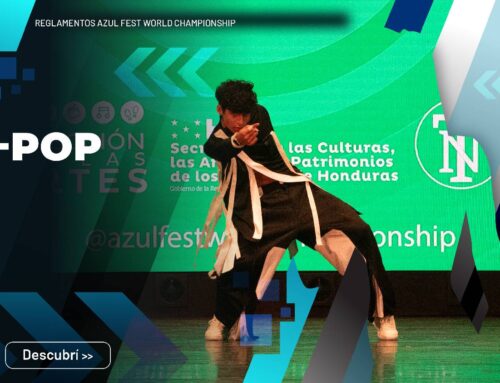ACRODANCE GUIDELINES:
AcroDance in Azul Fest It represents the perfect integration of acrobatic technique and artistic expression. This space invites participants to explore how acrobatic movements can be fused with dance to convey emotion, creativity, and fluidity.
Each choreography must reflect a harmony between acrobatics and dance, emphasizing narrative and musicality as key elements. AcroDance prioritizes fluidity in transitions, creativity in choreographic designs, and the performer's emotional connection with their audience.
The goal is for acrobatics to be part of the choreographic language and not isolated elements, promoting a complete experience where technique and artistry work together to captivate the audience.
CHOREOGRAPHY CATEGORIES AND TIMES
It is determined by Calendar Age, that is, it will depend on the year of birth of the participants and is calculated as follows:
Current Year – Year of Birth = Calendar Age
Example: 2025 – 2000 = 25 Years
SOLO/DUO/TRIO
| CATEGORY | AGE | MINIMUM TIME | MAXIMUM TIME |
|---|---|---|---|
| Baby | 3 to 6 years | 1:10 minutes | 1:50 minutes |
| Infant A | 7 to 9 years old | 1:10 minutes | 1:50 minutes |
| Infant B | 10 to 12 years old | 1:10 minutes | 1:50 minutes |
| Juvenile A | 13 to 15 years old | 2:00 minutes | 2:30 minutes |
| Juvenil B | 16 to 18 years old | 2:00 minutes | 2:30 minutes |
| Adult | 19 to 35 years old | 2:00 minutes | 2:30 minutes |
| Senior | +35 years | 2:00 minutes | 2:30 minutes |
| Professional | All ages | 2:00 minutes | 2:30 minutes |
| Mix | Mix of ages | 2:00 minutes | 2:30 minutes |
TEAMS/GROUPS/MEGA GROUPS
| CATEGORY | AGE | MINIMUM TIME | MAXIMUM TIME |
|---|---|---|---|
| Baby | 3 to 6 years | 2:00 minutes | 3:30 minutes |
| Infant A | 7 to 9 years old | 2:00 minutes | 3:30 minutes |
| Infant B | 10 to 12 years old | 2:00 minutes | 3:30 minutes |
| Juvenile A | 13 to 15 years old | 2:00 minutes | 3:30 minutes |
| Juvenil B | 16 to 18 years old | 2:00 minutes | 3:30 minutes |
| Adult | 19 to 35 years old | 2:00 minutes | 3:30 minutes |
| Senior | +35 years | 2:00 minutes | 3:30 minutes |
| Professional | All ages | 2:00 minutes | 3:30 minutes |
| Mix | Mix of ages | 2:00 minutes | 3:30 minutes |

There will be a tolerance of 10 seconds.
In the event of not complying with the regulatory time
may lead to the disqualification of the group.
Please cooperate, keep your time well.
In all cases the timing of the routine will begin
with the 1st choreographic movement or musical note and will end in the same way.
1. ACRODANCE TECHNIQUE
AcroDance is the fusion of dance and floor acrobatics, where technique plays a fundamental role in ensuring precise, harmonious, and safe execution. In this discipline, each movement must be supported by proper alignment, fluidity, and consistency with the artistic proposal.
1.1 Execution of movements (10 points)
Evaluates the precision, control and technical quality of both acrobatic and dance movements.
There are no restrictions on the dance styles used (contemporary, classical, Arabic, Spanish, urban, among others), as long as there is technical and artistic coherence in the fusion with acrobatics.
Body alignment will be assessed at all times, including landing, ground positions, and transitions from one movement to another.
Acrobatic and gymnastic movements are expected to be fluidly connected with dance steps, avoiding interruptions in the dynamics of the choreography.
In the technical execution, proper muscle activation and balance in body weight distribution will be evaluated, especially in turns, balance, falls, and ground movements.
In the “BABY” category, these requirements will be more flexible, prioritizing natural movement.
Performances with a lack of control, imbalances in posture, or acrobatic movements that do not integrate adequately with the dance will be penalized.


1.2 Transitions (10 points)
Evaluates the fluidity of the connection between acrobatic and dance elements, ensuring that transitions are harmonious and well-structured.
Transitions are expected to be smooth and organic, allowing each stunt to flow naturally within the choreography.
The use of level changes, turns, and movements will be assessed, ensuring that changes between standing and ground positions are fluid and technically correct.
The integration of jumps, rollings, balances, and falls must be performed precisely, without abrupt interruptions in the energy of the choreography.
The use of voice as an expressive resource is permitted within the proposal, provided that it is in accordance with the staging.
Transitions with a lack of control, abrupt interruptions, or disconnection between movements will be penalized.


1.3 Body control (10 points)
Evaluates the stability, alignment and control of the body in the execution of acrobatic and dance movements.
Proper core activation will be prioritized to maintain stability in each execution, especially in inverted positions or balances.
Harmony between the anteroposterior and lateral chains of the torso is expected, ensuring an aligned posture in every movement.
Hip-leg-foot alignment and coordination of the shoulder girdle with the arms and torso will be essential for refined technical control.
In falls and ground movements, absolute control of body alignment must be maintained, allowing fluidity and safety in the execution.
Performances with a lack of stability, loss of alignment, or movements that compromise the performer's safety will be penalized.


2. CHOREOGRAPHY IN ACRODANCE
AcroDance choreography is the harmonious combination of dance and floor acrobatics. The evaluation will include creative composition, fluid integration of elements, and strategic use of space to ensure a coherent and dynamic artistic performance.
2.1 Creativity and Originality (10 points)
It assesses the choreographer's ability to innovate within the framework of AcroDance, ensuring that the composition has identity and a strong visual impact.
The choreography is expected to maintain a fluid fusion of dance and acrobatics, avoiding mechanical or disconnected sequences.
Creativity in the combination of movements will be valued, ensuring that each element has a purpose within the artistic composition.
In group choreographies, the use of dynamic formations, level changes, and visual effects that reinforce the stage structure will be rewarded.
The use of the voice as an artistic resource is permitted, provided it is well integrated with the stage proposal.
Choreographies that are repetitive, lack structure, or fail to establish a clear connection between acrobatic and dance elements will be penalized.


2.2 Technical Complexity (10 points)
Analyze the difficulty level of the choreography in relation to the correct execution of dance steps and acrobatics.
The choreography is expected to include a variety of technical elements, such as spins, balances, falls, and floor combinations, executed with precision.
In group choreographies, the complexity also lies in the coordination of movements among the dancers, ensuring that everyone maintains a consistent technical level.
The correct integration of progressive acrobatic elements will be assessed, ensuring that the sequences are challenging but executed safely.
Choreographies that lack movement variation, lack technical challenge, or do not take advantage of the potential of AcroDance will be penalized.


2.3 Use of Space (10 points)
Evaluates the distribution and use of stage space within the choreography, ensuring a balanced and attractive staging.
The stage is expected to be strategically occupied, allowing each movement to have its own space to perform without interference.
In group choreography, movements and formation changes must be well organized, avoiding dead zones or unintentional transitions.
The combination of ground movements, inverted positions, and displacement sequences will be analyzed, ensuring that the visual composition is varied and dynamic.
Choreographies that do not take advantage of the stage space, disorderly movement, or poor layout that affects visual harmony will be penalized.


3. MUSICALITY IN ACRODANCE
Musicality in AcroDance is key to the integration of dance and acrobatics within the choreography. The performer's or group's ability to synchronize movements with the musical structure will be evaluated, taking advantage of changes in rhythm, accents, and pauses to enhance expressiveness and quality of performance.
3.1 Musical Performance (10 points)
Evaluate the relationship between movements and musical structure, ensuring that each performance reflects the energy and dynamics of the music.
In AcroDance, musicality must be precise and fluid, reflecting musical accents through dance and acrobatic movements.
Performers are expected to adjust their performance to changes in tempo, pauses, and nuances in the music, achieving a performance that is consistent with the chosen piece.
The dancers' ability to play with rhythmic variations will be assessed, ensuring that each acrobatic or floor movement has a clear rhythmic setting.
In group choreographies, collective synchronization with the music will be essential, ensuring that each member respects the timing and dynamic changes.
Performances that do not respect the musical structure, movements that are out of rhythm, or lack connection with the sound will be penalized.


Key Elements of Musicality in AcroDance




4. INDIVIDUAL PERFORMANCE AND GROUP COORDINATION IN ACRODANCE
This block assesses the quality of execution, precision, synchronization, and group cohesion within the choreography. In AcroDance, each movement must project control, fluidity, and confidence, ensuring an impactful performance both individually and as a group.
4.1 Individual Performance (Soloists) (15 points)
Evaluates the dancer's technical precision, body control, and stage presence throughout their performance.
Each performer is expected to maintain precise and controlled execution, ensuring alignment in every movement.
The performance should reflect strength, flexibility and fluidity, ensuring natural transitions between dance and acrobatics.
The quality of postural alignment, acrobatic technique, and body language will be assessed.
The execution must maintain a uniform intensity, avoiding drops in energy or movements without intention.
Inaccurate executions, lack of control in landing, incorrect alignment, or imbalances in performance will be penalized.

4.2 Synchronization and Cohesion (Duos, Trios, Teams, Groups and Mega Groups) (10 points)
Evaluates group coordination and uniformity in the execution of movements, ensuring that the whole group looks cohesive and visually balanced.
The group is expected to maintain precise synchronization in movements, formations, and combinations of acrobatics and dance.
In AcroDance, group cohesion is key to creating a harmonious and stylized performance.
All members will be assessed for performing movements with the same intention, projection, and level of control, avoiding noticeable differences in the quality of execution.
The uniformity of space distribution, the use of rhythmic accents, and the intensity of the group performance will be analyzed.
Mismatches in timing, energy gaps between members, or individual performances that disrupt group cohesion will be penalized.

4.3 Uniformity (Only for Duos, Trios, Teams, Groups and Mega Groups) (5 points)
Evaluates the homogeneity in the execution of movements, ensuring that all performers maintain the same aesthetic and technical level.
Consistency in posture, range of motion, and energy level will be measured, ensuring that the group remains cohesive at all times.
In group sequences, the intensity of movement and expressiveness must be balanced among all members.
Movements are expected to be precise and well-structured, avoiding imbalances that affect the visual harmony of the group.
Differences in performance between dancers, as well as variations in intensity or energy that disrupt the team's uniformity, will be penalized.
Key Elements of AcroDance Performance




5. VISUAL IMPACT IN ACRODANCE
Visual impact in AcroDance is a key element in enhancing the performance. The overall aesthetic of the presentation will be evaluated, including costumes, characterization, visual cohesion, and stage expression, ensuring that each element reinforces the style's identity and contributes to the choreography's artistic message.
5.1 Costume and Characterization (10 points)
Evaluate the coherence of the costume with the choreographic proposal and the identity of the AcroDance, ensuring that it reinforces the stage image without affecting the technical execution.
Costumes must be functional and safe, allowing freedom of movement without interfering with the execution of acrobatics and dance steps.
The use of colors, textures, and designs that reinforce the artistic concept of the choreography will be valued.
In group choreographies, the costumes must maintain visual cohesion, allowing the ensemble to project a uniform image without losing the individuality of each performer.
The materials are expected to be flexible and durable, avoiding elements that could snag or hinder movement.
Inappropriate clothing that restricts mobility or is inconsistent with the aesthetics of the proposal will be penalized.


Key Elements of Visual Impact in AcroDance




6. EMOTIONAL CONNECTION IN ACRODANCE
Emotional connection is a fundamental pillar of AcroDance, as it allows technique and acrobatics to gain meaning within the performance. Dancers will be evaluated on their ability to convey emotion, project energy, and reinforce the choreography's narrative through their expressiveness and stage presence.
6.1 Stage Projection (5 points)
Evaluates the attitude, presence, and expressiveness of the dancer or group on stage, ensuring that the performance reflects the artistic message of the choreography.
In AcroDance, the stage projection must be firm, expressive and enveloping, allowing each movement to be perceived with intensity and clarity.
Performers are expected to maintain a strong and consistent presence, ensuring that the energy of the performance never falters.
Facial expression, posture, and body language must be authentic and aligned with the choreographic proposal, avoiding forced gestures or emotional disconnection.
In group choreographies, all members will be assessed to ensure they convey the same intensity and commitment, avoiding noticeable differences in performance.
Lack of expressiveness, disconnection from the music, or lack of intention in movements will be penalized.


Key Elements of Emotional Connection in AcroDance




7. DEDUCTIONS IN ACRODANCE
To ensure fairness and compliance with competition standards, deductions will be applied if participants fail to meet certain technical or structural aspects of their presentation.
Deductions will be subtracted from the total score obtained in the evaluation and will apply to soloists, duos, trios, teams, groups, and mega groups.
7.1 Time Exceeded (3 points will be deducted for every 10 seconds over the maximum time allowed.)
Each category has a set time limit for submission.
If the total choreography time exceeds the maximum allowed, 3 points will be deducted for every additional 10 seconds.
The duration must strictly adhere to tournament regulations to avoid penalties.

7.2 Abrupt Musical Editing (5 points will be deducted if the music ends abruptly.)
The music editing should be clean and fluid, ensuring that the track ends naturally or with a proper closure.
If the music cuts off suddenly or without a fade out, a 5-point deduction will be applied.
The editing must be aligned with the choreographic concept, avoiding cuts that disrupt the performance experience.

Key Elements to Avoid Deductions




Important Note:
Restriction of Dangerous Movements:
The use of whiplash and whiplash is prohibited in the Baby and Children categories.
In the other categories, it is recommended to pay special attention to the choice of movements, always prioritizing the safety of the dancers.
Use of Elements and Accessories on Stage:
The choice of music should be related to the elements used and the story you want to tell or develop in the choreography.
It is recommended to create situations and construct narratives that can be adapted to the group, taking into account the age and profile of the dancers.
The use of adult stories in children's choreography is discouraged.
Rules on the Use of Scenic Elements:
There will be no restrictions on the use of props, as long as they are not watery or remain on the stage after the performance, as they could interfere with the next act.
The use of fire, flares, or flammable materials is prohibited, as they pose a risk to the safety of participants and the public.
If props are used, the group must remove them during the blackout to ensure the continuity of the event.
Consideration of Skills:
Skills from other disciplines or dance styles outside the competition will not be evaluated.
8. EVALUATION PROCESS
The evaluation process is based on a detailed form covering various aspects of the presentation. The items evaluated and their corresponding scores are detailed below:
Technique (30 points):
Precision, control, and technical quality in the execution of movements are assessed, including fluid transitions and body control.
Choreography (30 points):
Creativity and originality.
Technical complexity.
Efficient use of stage space.
Musicality (10 points):
Precise interpretation and connection with the rhythmic and dynamic elements of the music.
Execution (15 points):
Soloists (15 points):
Stage presence, individual projection, and the ability to maintain precision and expressiveness throughout the performance are valued.
Duos, Trios, Teams, Groups and Mega Groups (15 points):
It includes synchronization, cohesion and uniformity among the members, ensuring a homogeneous collective performance.
Visual Impact (10 points):
Costumes and characterization, aligned with the style and artistic proposal of the choreography.
Emotional Connection (5 points):
Ability to convey emotions, stage projection and connection with the audience.
Total: 100 points
Deductions:
Time exceeded: -3 points for every 10 seconds additional to the maximum allowed time (after the 10-second tolerance).
Abrupt musical edition: -5 points if the music ends abruptly.
And for the purposes of awarding points, the ranks are unified as follows:
9. RESPONSIBILITY OF THE TEACHER OR CHOREOGRAPHER
The teacher is responsible for the entry and exit of his students on stage, and for reviewing the manner of exit and entry.
He is legally responsible for each of his students and himself, and must sign a participation agreement before the event and present the documentation, including photocopies of the under-18 age categories, with the authorization of the parents.
The organization requires the instructor to take out liability insurance for their equipment, students, assistants, or companions, in case of injuries or any other damages that participants under their care may suffer. Otherwise, the instructor will be held responsible for any inconveniences arising from such incidents.
The teacher must have read and understood these regulations. I am only directing this to teachers who handle and use dance techniques with their students, understanding that they may be re-categorized depending on whether or not their presentation has the corresponding technique, and they may never discuss the jury's decision.
10. REQUIREMENTS AND FEES FOR PRESENTING CHOREOGRAPHY
IMPORTANT: Children under 2 (two) years old do not pay admission, but neither do OCCUPY SEAT, otherwise they will have to pay the same.
It is prohibited to occupy the aisles, standing or sitting, for whatever reason.
Each person must remain in their seat throughout the entire show.
It is the teacher's obligation to transmit these rules to his or her participating audience.
At the time of the awards ceremony, only the teacher representing his or her school will go up.
Only the instructor and one adult, duly identified by the production company, will be allowed into the dressing rooms. In the case of a group of more than 30 people, mostly children, one additional adult will be allowed in.
We are now available to answer any questions you may have.
Thank you very much for trusting azul-producciones




